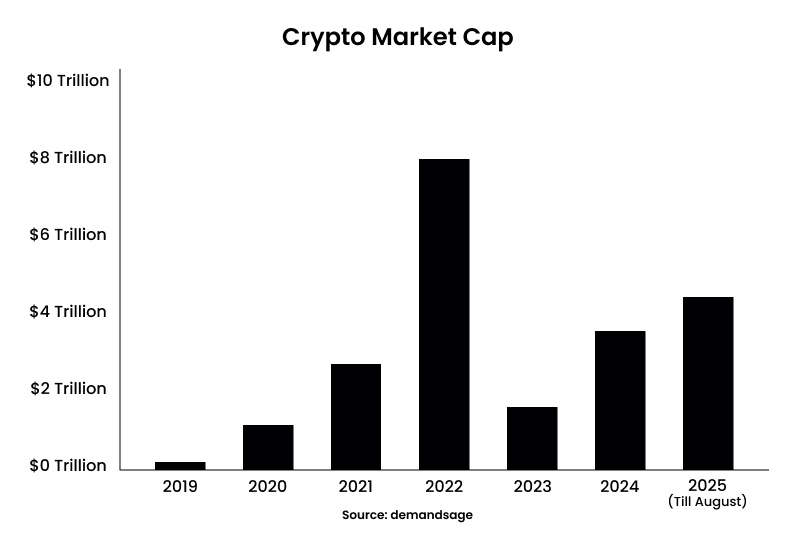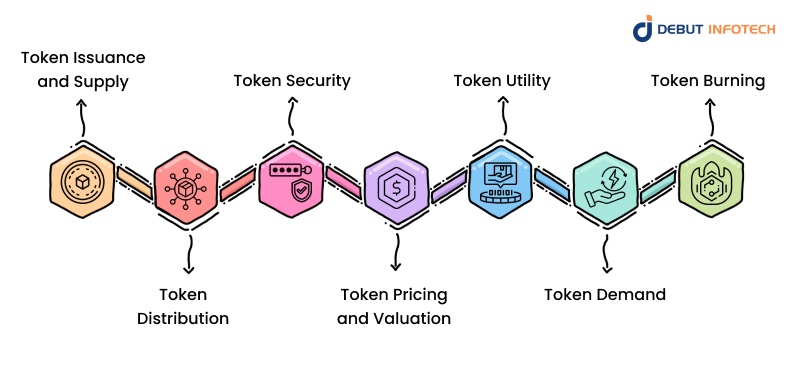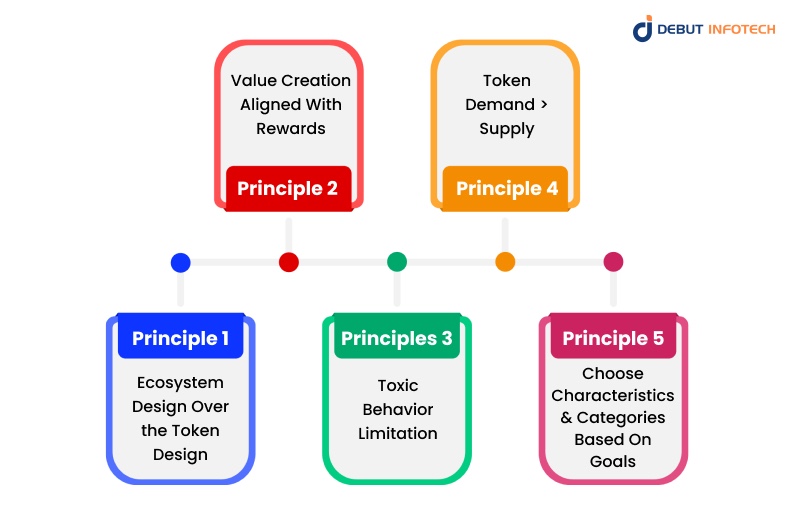Table of Contents
Home / Blog /
A Complete Guide to Crypto Tokenomics: Types, Features, and Importance
October 31, 2025

October 31, 2025
Tokenomics lies at the heart of every successful digital currency. It shapes how tokens are issued, distributed, used, and sustained within a blockchain ecosystem.
Proper crypto tokenomics can attract users, build trust, and align incentives across participants. Data from Triple-A indicates that around 6.8% of the global population (over 562 million) owned cryptocurrency in 2024. This shows the rising demand and adoption of cryptocurrencies.

Additionally, the total crypto market capitalization has surpassed $3.9 trillion in 2025, according to a DemandSage report.
Thoughtful token design reduces speculative volatility, aligns developer and user incentives, and embeds practical utility into products.
In this guide, we will discuss the meaning of tokenomics, its various models, why it’s crucial, and key features. We will also explain the factors to consider when designing sustainable tokenomics, provide real-life examples, and outline tokenomics design principles.
Create Tokens That Last
Create crypto tokens backed by robust, sustainable tokenomics that drive genuine long-term value, not fleeting short-term hype.
What is tokenomics in crypto?
Tokenomics—short for “token economics”—defines how a cryptocurrency functions within its ecosystem. It covers everything from token creation, supply mechanisms, and distribution, to how tokens gain and maintain value. In essence, crypto tokenomics determines the financial logic behind a crypto project’s success and sustainability. Without a solid tokenomic model, even strong blockchain concepts struggle to maintain long-term viability.
Why Tokenomics Matters in Crypto
Tokenomics is the economic engine behind every crypto project. It defines how tokens function, circulate, and retain value across their ecosystems.
1. Value Creation and Scarcity
Tokenomics drives value by managing supply and scarcity. A controlled or deflationary supply model ensures tokens remain rare, enhancing long-term value retention. Bitcoin’s limited 21 million cap is a perfect example—its predictable scarcity fuels investor confidence. It strengthens its position as a store of value within decentralized markets.
2. Investor Confidence and Trust
Transparent crypto tokenomics frameworks build trust among investors and users. When distribution rules, vesting periods, and supply schedules are clearly stated, investors understand the project’s economic stability. This predictability reduces uncertainty, encourages participation, and reassures stakeholders that token value isn’t subject to arbitrary inflation or insider manipulation.
3. Incentive Alignment
Strong tokenomics ensures every participant—developers, investors, and users—benefits from ecosystem growth. Incentives like staking rewards, governance rights, and token-based access create motivation to engage productively. This alignment not only drives adoption but also nurtures a sustainable cycle where community participation directly supports project development and long-term success.
4. Long-Term Viability and Growth
Sound tokenomics supports a project’s growth beyond short-term speculation. By aligning value creation with real utility and sustainable incentives, projects develop long-term ecosystems rather than fleeting hype. This approach helps maintain token relevance, supports active participation, and ensures stability even as market conditions fluctuate or investor sentiment shifts.
5. Sustainability
Economic sustainability is vital to avoid token dilution or price instability. Well-planned tokenomics introduces gradual emissions, controlled inflation, and mechanisms to balance supply and demand. These systems protect token value, encourage ongoing engagement, and help projects maintain operational stability while evolving naturally within competitive blockchain environments.
6. Practical Utility
Utility-driven tokenomics ensures that tokens serve a purpose beyond mere speculation. When tokens enable governance, transactions, staking, or access to platform features, they gain practical value. This usability enhances community retention, supports token circulation, and differentiates genuine projects from those that rely solely on short-term market excitement.
7. Supply-Demand Balance
Maintaining a balanced token economy is essential for market stability. Oversupply leads to rapid devaluation, while excessive scarcity can hinder participation. A well-calibrated supply-demand system ensures steady growth, allows room for organic appreciation, and keeps token value aligned with actual usage within the network’s ecosystem.
Read more – Top 15 Stablecoin Development Companies in 2025.
Key Features of Tokenomics
A well-structured crypto tokenomics framework relies on specific features that govern supply, demand, incentives, and governance to create a balanced and functional crypto economy.

1. Token Issuance and Supply
Token issuance defines the number of tokens in existence and how they’re introduced into circulation. Some tokens have a fixed cap, while others use inflationary schedules. A transparent issuance plan ensures predictability, helps maintain market confidence, and prevents uncontrolled inflation that could weaken token value over time.
2. Token Distribution
Token distribution determines who receives tokens and how fairly they’re allocated. Balanced distribution across developers, investors, and the community encourages decentralization. Projects that avoid heavy insider allocation typically gain stronger community trust, better governance participation, and more consistent token value across trading markets and long-term holders.
3. Token Security
Security protects the integrity of the token and investor funds. This includes smart contract audits, cold storage mechanisms, and multi-signature authorizations. Robust security measures not only reduce the risk of hacks or fraud but also reassure users that the project’s economic framework is safe, transparent, and professionally managed.
4. Token Pricing and Valuation
Valuation depends on perceived utility, scarcity, and market sentiment. When users see real-world applications, fair pricing, and transparent updates, token value stabilizes. Strong valuation frameworks also reduce speculation-driven volatility, enabling investors to assess a token’s worth through measurable factors such as network growth and user demand.
5. Token Utility
Utility determines how tokens function within the ecosystem—governance, payments, staking, or access to premium features. Projects that embed real use cases ensure active circulation. The broader the token’s role, the more it contributes to ecosystem stability and user retention across decentralized applications and marketplaces.
Related Read: Understanding Crypto Token Development: A Simple Guide for Starters
6. Token Demand
Sustained demand depends on usability, ecosystem growth, and user incentives. When people need the token to transact, stake, or access exclusive tools, demand becomes organic. Thoughtful tokenomics fosters this natural demand by tying rewards and benefits directly to user participation, creating lasting ecosystem engagement.
7. Token Burning
Token burning permanently removes tokens from circulation to regulate supply. This deflationary mechanism supports value appreciation and helps maintain scarcity. Projects often burn tokens during transactions or milestone achievements to stabilize price and reward long-term holders through gradual value growth across their ecosystem.
Different Types of Tokenomics Models
1. Inflationary Tokenomics Models
Inflationary models continuously add new tokens into circulation, often as staking rewards or mining incentives. This encourages participation, liquidity, and ecosystem expansion. However, inflation must be managed to prevent devaluation. A controlled emission rate maintains value while rewarding network activity.
Examples: Ethereum (ETH) and Dogecoin (DOGE).
2. Deflationary Tokenomics Models
Deflationary models reduce the total token supply over time through mechanisms such as burning or capped issuance. Scarcity boosts token value and promotes long-term holding. These systems appeal to investors who prefer predictable appreciation and limited inflationary risk. Balanced demand ensures growth without destabilizing markets.
Examples: Binance Coin (BNB) and Shiba Inu (SHIB).
Factors To Consider When Designing Sustainable Tokenomics
Building sustainable crypto tokenomics requires thoughtful design and planning. Every factor—from token supply to utility—must align with long-term goals and ensure market stability and user engagement.
1. Clear Utility
A token must serve a specific and valuable purpose. Whether it enables governance, supports a payment launchpad gateway, or staking, its function should tie directly to the ecosystem. A defined utility drives engagement, ensures long-term demand, and prevents the token from becoming speculative or irrelevant in real market conditions.
2. Balanced Allocation
Token allocation should distribute ownership fairly among stakeholders. Developers or companies offering crypto development services, investors, and community members must each hold reasonable shares to prevent centralization. Balanced allocation enhances governance participation, ensures trust, and promotes long-term community involvement while minimizing the risks of price manipulation or insider dominance.
3. Transparent Vesting Schedules
Vesting schedules control how and when tokens are released to early investors and team members. Transparent timelines prevent token dumps, stabilize price, and align stakeholder interests with project longevity. Clear release structures also demonstrate fairness and commitment to maintaining long-term value for investors and users.
4. Security Audits
Comprehensive tokenomics audits safeguard the project’s technical and economic integrity. Regular smart contract reviews, penetration testing, and external assessments help detect vulnerabilities. Effective auditing enhances investor confidence, ensures compliance with security standards, and fosters trust in the project’s ability to safeguard user funds and maintain stability.
5. Existing User Base
A project with an active community gains instant momentum. Designing tokenomics around an existing user base ensures adoption and steady demand. When users already believe in the project, introducing incentives through tokens strengthens loyalty, encourages usage, and drives continued participation in the ecosystem.
6. Full Disclosures
Transparency is fundamental in meme coin development and crypto in general. Disclosing all relevant token metrics, distribution details, and future plans helps prevent misinformation and fosters trust. Investors are more likely to engage with projects that openly communicate their goals, risks, and token behavior across market conditions and governance processes.
7. Demand Drivers
Token demand should stem from genuine ecosystem value, not speculation. Features like staking, governance rights, and platform access drive consistent usage. Identifying and reinforcing these drivers early creates stable demand, increases token circulation, and supports sustainable price appreciation over time.
8. Supply Control
A predictable and well-managed supply helps stabilize token value. Mechanisms such as burning, minting limits, or gradual emissions help prevent inflationary pressure. Controlled supply ensures scarcity remains meaningful while allowing enough liquidity for network growth, staking rewards, and user engagement across the ecosystem.
9. Long-Term Incentives
Sustainable growth depends on incentives that reward consistent participation. Reward systems for staking, referrals, or governance must align with user commitment. When incentives encourage ongoing contribution instead of quick gains, token ecosystems grow stronger and retain active users over extended periods.
10. Regulatory Compliance
Adhering to global regulatory standards ensures the long-term legitimacy of projects. Proper licensing, adherence to anti-money laundering (AML) regulations, and transparent token classification protect both users and developers. Compliance minimizes legal risks, promotes investor confidence, and opens opportunities for institutional adoption in regulated markets.
Tokenomics Design Principles
Effective crypto tokenomics design is guided by principles that promote fairness, transparency, and sustainability, while maintaining a viable token ecosystem over time.

1. Ecosystem Design Over the Token Design
Token development companies must prioritize building a sustainable ecosystem rather than focusing solely on token characteristics. Tokens derive value from their network’s health, not isolated scarcity. A thriving ecosystem encourages continuous use, stable circulation, and meaningful integration, creating stronger fundamentals for long-term market resilience and real-world utility.
2. Value Creation Aligned With Rewards
Rewards must reflect genuine contributions to the ecosystem. Participants should earn benefits through meaningful engagement, such as staking, governance voting, or developing tools. When rewards align with value creation, token systems remain fair, productive, and capable of fostering consistent growth without encouraging speculative or manipulative behaviors.
3. Toxic Behavior Limitation
A well-structured tokenomic model discourages harmful activities, such as price manipulation, pump-and-dump schemes, or governance exploits. Mechanisms such as vesting restrictions, slashing penalties, and voting safeguards preserve fairness. Limiting toxic behavior ensures a healthier economy, sustained investor confidence, and an inclusive environment for genuine ecosystem participants.
4. Token Demand > Supply
Healthy tokenomics ensures that real demand consistently exceeds available supply. This balance stabilizes prices and fosters organic appreciation. By linking demand to functional use cases—like governance, access, or staking—projects maintain token relevance while preventing inflationary pressures or artificial scarcity that could distort market behavior.
5. Choose Characteristics & Categories Based On Goals
Token design should always reflect project objectives. Utility, governance, and security tokens each serve distinct purposes. Choosing the right model determines how users interact, invest, and engage with the product. When token characteristics align with project goals, it creates a coherent structure that supports both usability and long-term vision.
Read Also – Top Reasons Why Businesses Are Investing in Token Development
Build With Experts Who Understand Value
Partner with our team to develop crypto tokens rooted in sound economic logic and sustainable design.
Real-Life Examples of Tokenomics
Here are some tokenomics examples:
1. SUI Tokenomics
SUI operates on a proof-of-stake model emphasizing scalability and efficiency. Its tokenomics structure rewards validators and delegators while allocating resources to developer grants and ecosystem growth. Transaction fees and staking incentives ensure continuous participation, while capped supply and transparent governance promote long-term value retention and balanced ecosystem sustainability.
2. Arbitrum Tokenomics
Arbitrum’s ARB token supports governance within its Layer-2 network, enabling holders to propose and vote on ecosystem decisions. The allocation strategy divides tokens among the DAO treasury, core contributors, and early supporters, ensuring equitable participation. Its structure promotes decentralization, transparency, and sustainable incentives that maintain alignment between community goals and project growth.
3. Chainlink Tokenomics
Chainlink’s LINK token powers its decentralized oracle network, rewarding node operators for providing reliable off-chain data to smart contracts. The model ties performance with compensation—only trustworthy data providers earn rewards. This self-sustaining approach strengthens Chainlink’s ecosystem by incentivizing accuracy, promoting trust, and reinforcing long-term participation across multiple blockchain integrations.
Looking for A Reliable Partner for Sustainable Token Design?
As the crypto space matures, the need for reliable tokenomics development partners grows stronger.
Debut Infotech is a reputable crypto token development company that designs sustainable token systems grounded in transparent allocation, practical utility, and long-term incentives. Our teams conduct comprehensive security audits, implement clear vesting schedules, and ensure regulatory alignment. By prioritizing ecosystem utility and balanced emission models, we help clients attract genuine users and institutional investors.
Our approach focuses on measurable growth metrics, developer support, and iterative testing, delivering token economies that scale responsibly while maintaining investor confidence and operational resilience. We also provide post-launch monitoring and community governance support to ensure adaptability.
Conclusion
A solid understanding of crypto tokenomics distinguishes successful blockchain projects from those that are short-lived. Every token’s utility, reward model, and governance setup significantly impact its long-term adoption and stability.
Sustainable design means balancing scarcity with accessibility, ensuring incentives motivate participation without inflating supply. Projects like SUI and Chainlink prove that well-structured tokenomics drives real ecosystem value.
As the market grows more competitive, developers and investors who understand token economics will be better equipped to build, scale, and sustain meaningful blockchain innovations for years to come.
FAQs
A. Good tokenomics means a crypto project has a fair token supply, strong utility, and clear incentives for holders. It balances demand and supply, rewards long-term users, and prevents inflation. Projects with transparent distribution and sustainable reward models tend to exhibit stronger growth and garner greater investor trust.
A. You can start crypto tokenomics analysis by checking total supply, token distribution, and how tokens are used. Look for lock-up periods, burn mechanisms, and staking rewards. Review the whitepaper and study the project’s roadmap. Also, see how demand is created—strong utility and real-world use cases often signal solid tokenomics.
A. The primary purpose of tokenomics is to establish a stable, self-sustaining economy for a crypto project. It defines how tokens move within the ecosystem, reward participants, and maintain value. In short, tokenomics keeps the system fair, profitable, and attractive for both users and investors.
A. Look for cryptos with limited supply, transparent distribution, and genuine use cases. Projects that reward holders, prevent inflation, and ensure long-term sustainability tend to have strong tokenomics. Avoid tokens with unclear allocation or massive insider control, as this often signals weak or manipulative economics.
A. You can find tokenomics details in a project’s whitepaper or official website. Many analytics sites, such as CoinMarketCap, Messari, and CoinGecko, also summarize key token data. Social channels and community forums are proper too—but always cross-check facts before investing.
Talk With Our Expert
USA
2102 Linden LN, Palatine, IL 60067
+1-708-515-4004
info@debutinfotech.com
UK
Debut Infotech Pvt Ltd
7 Pound Close, Yarnton, Oxfordshire, OX51QG
+44-770-304-0079
info@debutinfotech.com
Canada
Debut Infotech Pvt Ltd
326 Parkvale Drive, Kitchener, ON N2R1Y7
+1-708-515-4004
info@debutinfotech.com
INDIA
Debut Infotech Pvt Ltd
Sector 101-A, Plot No: I-42, IT City Rd, JLPL Industrial Area, Mohali, PB 140306
9888402396
info@debutinfotech.com

Leave a Comment